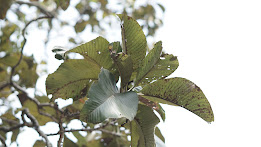Dillenia pentagyna Roxb. dalam Bahasa Indonesia klik di sini
Dillenia pentagyna Roxb.
Source:
Private document, 2022
Taxonomy
Kingdom: Plantae
Phylum: Tracheophyta
Subphylum: Angiosperms
Class: Magnoliopsida
Order: Dilleniales
Family: Dilleniaceae
Genus: Dillenia
Spesies: Dillenia pentagyna Roxb
(Metcalfe & Chalk, 1983)
Morphology
This tree can grow up
to 30 m, has smooth grey bark while the young bark is brownish-gray; alternate
leaves, oblong, blunt, leaf margins is serrated about 15-20 cm long; and yellow
flowers that have a distinctive aroma (Gandhi & Mehta, 2013).
Distribution
& Habitat
This plant is
distributed in India, Thailand, Myanmar, Indochina, South China, Thailand, Java
Island, Nusa Tenggara, and South Sulawesi. This type of plant grows a lot in
the tropics and subtropics (Prosea, 1995).
Potential
Dillenia pentagyna
contains a lot of triterpenoid, flavonoid, and tannin (Gandhi & Mehta,
2013). The bark of this plant contains phenolic and flavonoid compounds. This
compound has a redox that act as a hydrogen reducer and donor, so that it is an
antioxidant. This plant has anti-inflammatory activity on its bark (Zothanpuia
and Kakoti: 2017). According to Murningsih (2019) this plant is rich in triterpenoid,
flavonoid, tannin, and various phytoconstituent contents. The bark contains a
good anti-tumor. Has a good theurapeutic potential.
Usability
This plant is widely used as a shade plant by the
roadside or in the yard of the house. Its unripe fruit can be cooked and made
pickled, while the ripe fruit can be eaten. The roots can be used as analgesic
for the body. The bark can be processed into powdered medicine for diabetes,
diarrhea and dysentery. Its leaves can be used to heal wounds and heal skin
diseases and are used to help cure breast cancer (Prosea: 1995). Gandhi &
Mehta (2013) states that the bark of dillenia pentagyna has good antitumor and teurapeutics.
References
Liana & Murningsih, T. (2018). Aktivitas Antioksidan,
Kandungan Fenolat dan Flavonoid Total Ekstrak Kulit Batang Dillenia auriculata
(Dilleniaceae). Pros Sem Nas Masy Biodiv Indon, 5(1): 129-133.
Zothanpuia, & Kakoti, B.K. (2017). In vitro and in vivo
anti-inflammatory activity of Dillenia pentagyna Roxb. bark, a folklore
medicine of Mizoram. Sci Vision 17 (2): 69-77.
Prosea (1995). Plants Resources
of Shout East-Asia vol.5. Bogor: Prosea Foundation.
Gandhi D. & Mehta P. (2013). Dillenia Indica Linn. And Dillenia Pentagyna Rocb.: Pharmacognostic, phytochemical and therapeutic aspect. Journal of Pharmaceutical Science Vol. 3(11), pp. 134-142.





0 Komentar